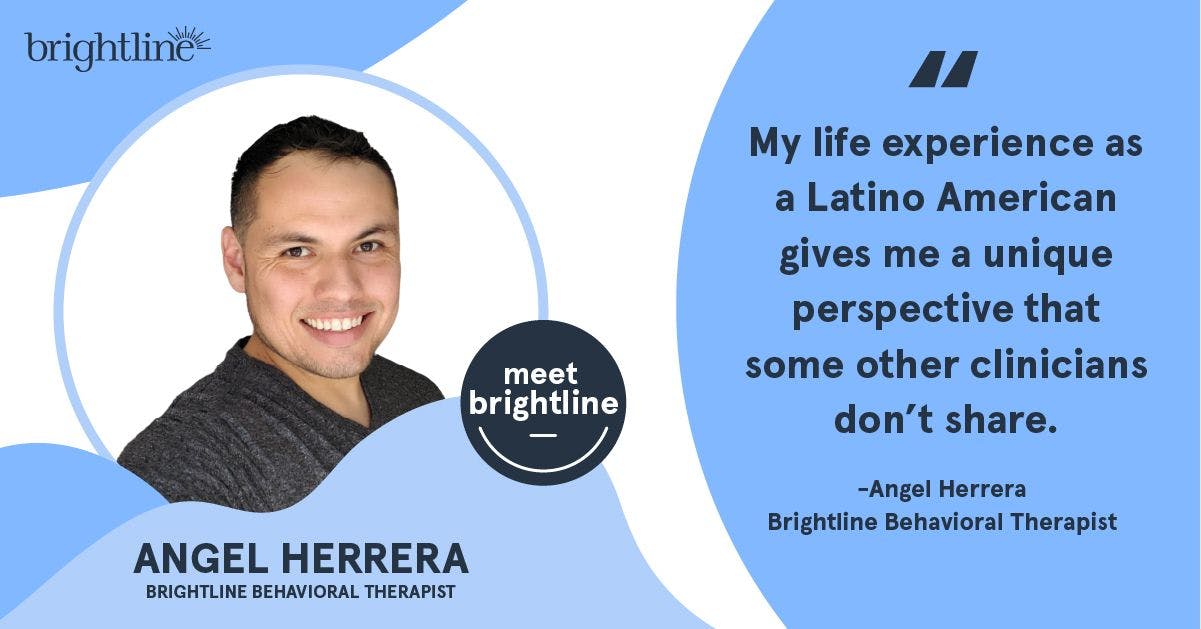
“My desire is to create a safe space for families” — Brightline coach spotlight

By Brightline team, Sep 21, 2021
As a first generation Latino American who felt the pressure of serving as his mother’s translator throughout his adolescent years, Brightline therapist Angel Herrera has personally experienced some of the struggles common to today’s Hispanic and Latinx youth.A bilingual therapist, Angel works with children and adolescents experiencing behavioral issues related to anxiety, ADHD, depression, and trauma. His passion is working with underprivileged youth and families, and he brings a heightened cultural awareness and sensitivity to the Hispanic and Latinx communities specifically.In this interview, Angel discusses what inspired him to become a therapist and how his unique perspective of cultures helps him better connect with the children and families he works with.What made you want to become a therapist?I was first introduced to psychology in high school, and found it immediately fascinating — which led me to pick psychology as my major once I started college. At that time, though, because there’s so much you can do with a psychology major, I wasn’t sure if I would go into the clinical side of the field . At one point, I even considered going into human resources!But over time I came to realize that I really wanted to help people very directly. I started volunteering, working with kids, and from there I got a traineeship at a children’s hospital in San Diego. I worked with kids and families in an outpatient hospital setting and realized how much I enjoyed it. That clinched the decision.When I was a kid myself, I actually wanted to be a cartoonist. Funny thing is, I actually get to do some drawing now when I work with kids! Art is one creative and therapeutic way I connect with the children I work with.Did you specifically seek to work with the Hispanic or Latinx communities?I recognize that my life experience as a Latino American gives me a unique perspective that some other clinicians don’t share. Hispanic and Latinx children have their own set of behavioral health challenges, most often related to the effects of racism, the need to learn a new language, the pressure of translating for parents, and more.As a therapist who is Latino American, I have the privilege and advantage of being able to understand, when working with Latinx families, some of the underlying cultural factors that may fall under the radar for those outside this population. And I’ve also found that Latinx parents and caregivers tend to be more comfortable having as a therapist for their child someone who is from and familiar with their culture. It helps address issues around mental health stigma, because those cultural factors are always at play — especially when we’re talking about our feelings and emotions. There is a connection, and a feeling of connection is very important within the Latino community.What is it that you enjoy about working with kids and their families?Working with kids allows for more creativity. From a clinician’s perspective, in order to engage kids, you can’t just sit them down and talk to them for an hour. Most kids can’t do that. I can do it, but I would much rather be moving around or doing something with my hands, just like kids prefer.Also, working with kids and their families means I get to see so much positive change. With kids especially, we tend to see more noticeable change happen. They’re generally more open to therapy than adults are, so it’s very rewarding as a clinician to see small but significant changes.Working with the family is such a crucial element. It’s almost impossible to achieve long-term results for a child without parent involvement. I do a lot of parent coaching and family therapy for that reason, and that’s something I truly enjoy.What specifically brought you to Brightline?I truly appreciate and share Brightline’s mission and passion. I find therapy to be most effective when the family is involved, along with all providers of the various treatments a child is receiving. From the behavioral therapies to medications being prescribed, if you don’t communicate with all parties involved, things fall through the cracks.In order to understand a child’s mental health, you really need an understanding of the physical and biological factors also at play. It’s all related. Brightline is a one-stop-shop for behavioral health, with everyone working closely and communicating for the benefit of clients. As a clinician, this process makes it easy to address all the potential areas that need attention.We’re in the midst of Hispanic Heritage Month. What do you think employers should do to acknowledge this month, and what do they need to think about when it comes to the behavioral health of their Hispanic and Latinx employees?I think employers should recognize National Hispanic Heritage Month — and that we really should celebrate all cultures throughout the year. Employers should make celebrating cultures part of the company culture, with employees encouraged and invited to talk openly.More specifically for this month, I feel employers need to make a concerted effort to reduce stigmas around mental health, so that more people in the Hispanic and Latinx communities feel they can reach out for support if and when they need it. Ignoring the problem is part of the problem.And of course, employers can support Latinx employees by making behavioral health care readily available — and ensuring that the care provided is culturally competent. This will set things up for the best outcome for both employees and their children.Angel Herrera is a licensed behavioral therapist at Brightline who specializes in working with children, adolescents, and their families, providing care for issues related to anxiety, ADHD, depression, and trauma. He received his bachelor of arts in psychology from California State University San Marcos, and his master of arts in marriage and family therapy from Alliant International University.